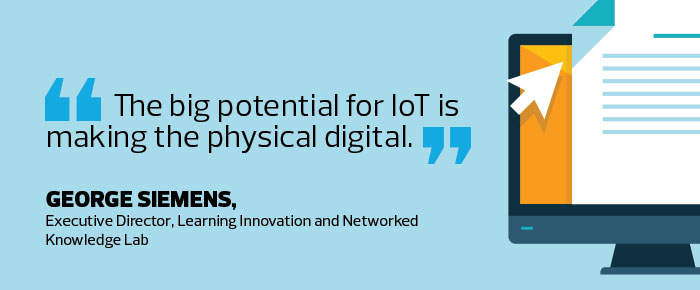How Will the Internet of Things Impact Education?
Internet of Things technology is all around us. From cars to dishwashers, everyday items are becoming connected devices. So, how does that connectedness translate to the future K–12 classroom?
According to a 2016 survey by Extreme Networks, smart schools are using IoT technology to track school buses, attendance and student ID cards, and to monitor lighting and security systems, among other things.
“The IoT is still very much in its infancy,” says George Siemens, the executive director of the University of Texas at Arlington’s Learning Innovation and Networked Knowledge Lab.
Siemens predicts the IoT will make a large impact. “The big potential for IoT lies in making the physical digital,” he says, adding that not only items, but also people can be marked and tracked digitally.
Possible IoT Applications
Automatic attendance tracking using radio frequency identification is one potential application at the K–12 level. An RFID chip could be imbedded in a student’s ID card or mobile device, and would be constantly trackable.
“We might look at how students move through the school during the day. Who do they study with? Who do they play with at recess? We might see certain groups interacting to promote better grades, or to complement their own knowledge or skill sets,” Siemens says.

Wearable IoT devices such as fitness bands, watches and virtual reality headsets may find their way into more classrooms. Muse, a headband that reports brain activity to a mobile app, could help teachers monitor student engagement and track learning styles.
Security and personal privacy issues arise in every potential application of IoT, and this type of student tracking is no exception. “There’s tremendous potential and significant risk,” Siemens says. “We have to ask ourselves, should we be tracking our students at a granular level?”
Another potential issue with IoT use in the K–12 environment is the digital divide, says David Logsdon, senior director of public advocacy for new and emerging technologies at CompTIA, a nonprofit trade association.
“Like almost anything else, wealthier cities, counties and states are much more progressive in terms of utilizing all the capabilities of IoT, as opposed to rural states and low-income communities,” Logsdon says.
Navigating an IT Cultural Change
Combating the divide is important, Logsdon says, because IoT could dramatically change the learning environment. “Through IoT technology, you can push out real-time information to students from multiple sources, rather than using one outdated textbook,” he says. “It’s a cultural change for educators as well — not just teaching from a textbook but being able to have real-time data.”
As price points for IoT devices and broadband internet connections fall, Logsdon believes connected classrooms will enrich the learning experience for students in every state.









